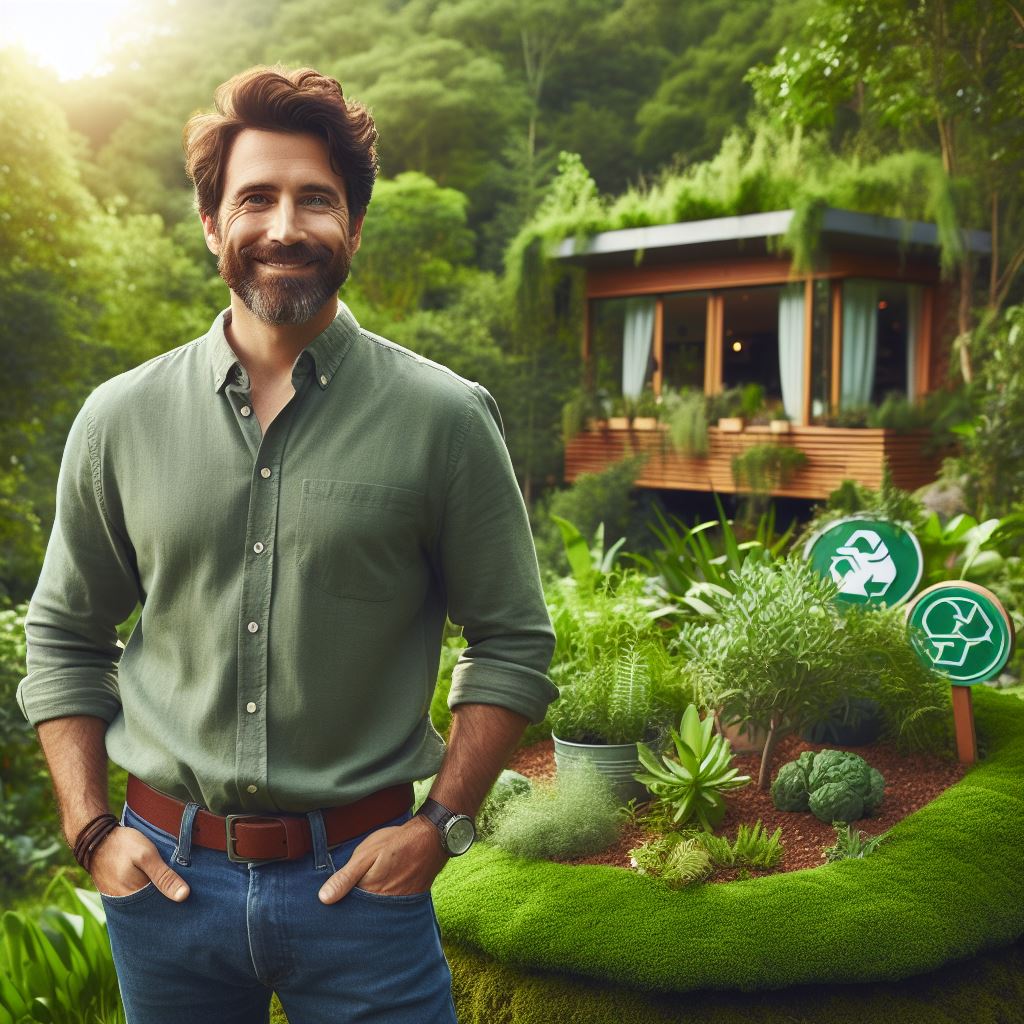Introduction
Sustainable landscaping has emerged as a crucial aspect of responsible property management, fostering environmental consciousness and minimizing ecological footprints.
In this blog post, we delve into the realm of sustainable landscaping, exploring its definition, underscoring its importance for properties, and providing a preview of the insightful content that follows.
Sustainable landscaping goes beyond conventional practices, focusing on creating outdoor spaces that harmonize with nature, promote biodiversity, and conserve resources.
It is a holistic approach that considers the environmental impact of landscaping choices, encompassing everything from plant selection to water usage and maintenance practices.
Sustainable landscaping involves using native plants that thrive in local conditions, reducing the need for excessive watering, fertilizers, and pesticides.
It also entails incorporating eco-friendly materials for hardscaping elements and implementing efficient irrigation systems.
By adopting these practices, sustainable landscaping strives to create resilient, low-maintenance ecosystems that contribute positively to the surrounding environment.
The significance of sustainable landscaping extends beyond aesthetics.
It plays a pivotal role in mitigating climate change, conserving water resources, and fostering a healthier environment.
Properties embracing sustainable landscaping practices witness a reduction in energy consumption, as strategically placed trees provide shade and insulation, reducing the need for excessive heating or cooling.
Furthermore, sustainable landscapes act as a habitat for local wildlife, promoting biodiversity and creating a balanced ecosystem.
As properties become more sustainable, they contribute to the overall well-being of the community and the planet.
Throughout this blog post, we will explore specific strategies for achieving sustainable landscaping, including plant selection tips, water conservation methods, and the integration of renewable energy sources.
We will also delve into the economic benefits of sustainable landscaping, such as increased property value and reduced maintenance costs.
Stay tuned for practical insights and actionable tips to transform your property into a haven of sustainability.
Transform Your Real Estate Decisions
Unlock personalized real estate insights crafted just for you. Get actionable advice designed to amplify your success.
Get StartedLet’s embark on this journey towards responsible and environmentally conscious landscaping practices.
Benefits of Sustainable Landscaping
Sustainable landscaping offers numerous benefits that go beyond just aesthetic appeal.
Implementing such practices contributes to a greener environment, stronger economy, and healthier societies.
Environmental benefits
Conserving water is a primary advantage of sustainable landscaping.
By implementing efficient irrigation systems, utilizing rainwater harvesting, and selecting drought-resistant plants, water consumption can be significantly reduced.
This not only helps preserve this precious resource but also lowers water bills.
Furthermore, sustainable landscaping aims to reduce chemical usage.
Instead of relying heavily on synthetic fertilizers and pesticides, organic alternatives and natural means are prioritized.
This approach safeguards the soil, water bodies, and surrounding ecosystems from harmful chemical runoff, preserving the integrity of the environment.
Another significant environmental benefit is the promotion of biodiversity.
Sustainable landscaping emphasizes the use of native plants that support local wildlife.
These plants provide habitats and food sources for various species, leading to a more diverse and thriving ecosystem.
Increased biodiversity also aids in pollination, pest control, and overall ecosystem stability.
Economic benefits
Sustainable landscaping practices yield substantial economic advantages.
Showcase Your Real Estate Business
Publish your company profile on our blog for just $200. Gain instant exposure and connect with a dedicated audience of real estate professionals and enthusiasts.
Publish Your ProfileBy opting for water-efficient systems and making proper use of mulch and soil amendments, water usage can be minimized, resulting in lower water bills.
Additionally, incorporating energy-efficient measures such as strategically placed trees for shade and proper insulation reduces energy consumption, leading to reduced energy costs.
A well-maintained sustainable landscape also enhances property value.
A visually appealing and functional landscape not only attracts potential buyers but also creates a positive first impression.
Studies have shown that properties with sustainable landscapes tend to sell at higher prices and spend less time on the market, making it a wise investment.
Social benefits
Sustainable landscaping positively impacts the well-being of individuals and communities.
By incorporating green spaces and natural elements, it improves air quality by capturing pollutants, reducing dust, and producing oxygen.
Additionally, sustainable landscapes help mitigate noise pollution by acting as buffers, resulting in more peaceful and pleasant living environments.
Being surrounded by nature and greenery also has significant psychological and physical benefits.
Studies have highlighted that exposure to nature reduces stress levels, improves concentration, and boosts overall mood and happiness.
Access to green spaces encourages physical activities and promotes healthier lifestyles, leading to improved well-being and a sense of community.
In fact, sustainable landscaping offers a multitude of benefits, ranging from environmental conservation to economic profitability and social well-being.
By implementing these practices, individuals and communities can contribute to a more sustainable future while enjoying a beautiful and healthier living environment.
Read: Water-Saving Tips for Property Managers
Key Sustainable Landscaping Principles
Sustainable landscaping for properties encompasses several key principles that promote environmental stewardship and reduce resource consumption.
By implementing these principles, property owners can create beautiful landscapes while also preserving natural resources and supporting local ecosystems.
Water conservation
Water conservation is essential for sustainable landscaping.
Efficient irrigation systems, such as smart sprinklers and drip irrigation, minimize water waste by delivering water directly to plants without excess runoff.
Additionally, selecting drought-tolerant plants and exploring turf alternatives can significantly reduce water usage.
These plants are adapted to local climates and require less irrigation.
Rainwater harvesting techniques provide another avenue for water conservation.
By collecting and storing rainwater in barrels or cisterns, property owners can utilize this free resource to water plants and gardens, reducing the need for tap water.
This sustainable practice also helps prevent stormwater runoff, which can carry pollutants into water bodies.
Soil health and fertility improvement
Improving soil health and fertility is crucial for sustainable landscaping.
Composting is an effective method for recycling organic waste into nutrient-rich compost, which can be used to enrich the soil.
Mulching is also beneficial as it retains moisture, suppresses weeds, and slowly adds organic matter to the soil.
To minimize environmental harm, it is essential to avoid chemical fertilizers and instead opt for natural alternatives such as organic fertilizers.
Plant selection and maintenance
Plant selection and maintenance play a vital role in sustainable landscaping.
Choosing native plants that are adapted to the local environment not only conserves water but also supports local wildlife.
Native plants provide food and habitat for insects, birds, and other animals, promoting biodiversity.
Showcase Your Real Estate Business
Publish your company profile on our blog for just $200. Gain instant exposure and connect with a dedicated audience of real estate professionals and enthusiasts.
Publish Your ProfileAdditionally, practicing proper pruning techniques and pest control methods keeps plants healthy and minimizes the need for harmful pesticides.
Energy efficiency
Energy efficiency is another essential aspect of sustainable landscaping.
Strategic tree placement can provide shade and reduce the need for air conditioning during hot summer months.
Creating windbreaks with hedges or fences helps protect the property from cold winds, reducing heat loss and energy consumption.
Furthermore, utilizing solar-powered outdoor lighting reduces reliance on electricity and contributes to a greener energy footprint.
In short, implementing key sustainable landscaping principles is essential for property owners who wish to create environmentally friendly landscapes.
By conserving water, improving soil health, selecting and maintaining plants wisely, and promoting energy efficiency, individuals can contribute to a more sustainable and resilient future.
Read: Smart Tech for Eco-Friendly Properties

Implementing Sustainable Landscaping Practices
Implementing sustainable landscaping practices requires careful planning and a systematic approach.
By following these steps, property owners can create beautiful and eco-friendly landscapes that contribute to a healthier environment.
Site assessment and planning
Before beginning any landscaping project, conducting a thorough site assessment is essential.
This involves analyzing the existing conditions such as soil quality, drainage patterns, sun exposure, and existing vegetation.
This information will help in making informed decisions about the design and layout of the sustainable landscape.
Setting clear goals and priorities is the next step in the planning process.
What is the purpose of the landscape? Is it to provide visual appeal, conserve water, attract wildlife, or provide a space for outdoor activities? By prioritizing these goals, property owners can focus their efforts on the most important aspects of their sustainable landscaping project.
Engaging professionals or seeking guidance
While some property owners may have the knowledge and skills to design and implement a sustainable landscape on their own, others may benefit from hiring a sustainable landscape designer.
These professionals are trained in eco-friendly design practices and can ensure that the project meets the desired goals and standards.
Collaborating with local organizations or nurseries can also be helpful in obtaining guidance and resources.
These entities often have expertise in native plants, water conservation techniques, and environmentally-friendly maintenance practices.
Their knowledge and support can greatly contribute to the success of a sustainable landscaping project.
Steps for transitioning to sustainable landscaping
Removal of non-native and invasive plants
One of the first steps in transitioning to a sustainable landscape is removing non-native and invasive plant species.
These plants can have detrimental effects on local ecosystems by outcompeting native species for resources.
By replacing them with native plants, property owners can create a more balanced and resilient landscape.
Soil testing and improvement
Soil quality is crucial for the health and vitality of plants.
Conducting a soil test can provide valuable information about its nutrient content and pH levels.
Based on the results, property owners can make amendments to improve the soil’s fertility and structure, ensuring optimal conditions for plant growth.
Selecting appropriate plants and materials
Choosing plants and materials that are well-suited to the local climate and soil conditions is essential for sustainable landscaping.
Native plants are often the best choice as they are adapted to the regional environment and require less water and maintenance.
Utilizing organic fertilizers and mulches can also minimize the use of harmful chemicals.
By implementing these practices and following a systematic approach, property owners can successfully transition to sustainable landscaping.
Showcase Your Real Estate Business
Publish your company profile on our blog for just $200. Gain instant exposure and connect with a dedicated audience of real estate professionals and enthusiasts.
Publish Your ProfileBy creating landscapes that are in harmony with nature, they contribute to the preservation of biodiversity, conservation of resources, and the overall well-being of the environment.
Read: Solar Power: Brightening Property Management
Tips for Maintaining Sustainable Landscaping
Sustainable landscaping not only enhances the aesthetic appeal of your property but also contributes to a healthier environment.
Once you’ve established a sustainable landscape, it’s crucial to maintain it effectively.
Here are essential tips to keep your green oasis thriving while minimizing environmental impact.
Watering Techniques and Schedules
Water is a precious resource, and efficient use is key to sustainable landscaping.
Consider installing a drip irrigation system to deliver water directly to plant roots, reducing wastage.
Set up a schedule based on the specific needs of your plants, factoring in weather conditions.
Water early in the morning or late in the evening to reduce evaporation.
Proper Pruning and Trimming Methods
Regular pruning and trimming not only maintain the shape and beauty of your plants but also contribute to their overall health.
Use sharp, clean tools to avoid unnecessary damage. Focus on removing dead or diseased branches to encourage new growth.
Additionally, consider shaping your plants to promote airflow, preventing the onset of diseases.
Mulching and Fertilizing Strategies
Mulching serves as a natural insulator, regulating soil temperature and moisture.
Opt for organic mulch, such as bark or compost, to improve soil quality over time.
Use natural fertilizers to nourish your plants without harmful chemicals, promoting a healthy and balanced ecosystem within your landscape.
Managing Pests and Weeds Naturally
Avoid harmful pesticides that can harm beneficial insects and disrupt the natural balance of your garden.
Introduce natural predators like ladybugs or use neem oil to control pests.
For weed management, employ manual removal or use eco-friendly herbicides, maintaining a chemical-free environment.
Regular Monitoring and Adjustments
Stay vigilant by regularly inspecting your landscape for signs of stress, disease, or pest infestations.
Adjust your maintenance practices accordingly, whether it’s modifying watering schedules, addressing nutrient deficiencies, or introducing natural deterrents.
Early intervention can prevent issues from escalating and maintain the sustainability of your landscaping efforts.
By implementing these maintenance tips, you not only preserve the beauty of your sustainable landscape but also contribute to the well-being of the planet.
Sustainable landscaping is a continuous commitment that rewards both your property and the environment.
Read: Green Waste Management in Modern Properties
Case Studies: Successful Sustainable Landscaping Projects
When it comes to sustainable landscaping, residential and commercial properties alike can benefit from incorporating eco-friendly practices.
Let’s explore some case studies that demonstrate successful sustainable landscaping projects.
Residential property examples
Water-efficient landscape redesign
In this particular case, a residential property underwent a landscape redesign with a focus on water efficiency.
The traditional grass lawn was replaced with drought-tolerant plants and indigenous vegetation.
By using mulch and smart irrigation systems, water consumption was significantly reduced, resulting in both cost savings for the homeowner and conservation of a valuable resource.
Native plant garden transformation
Another inspiring example involves the transformation of a garden by incorporating native plants.
Showcase Your Real Estate Business
Publish your company profile on our blog for just $200. Gain instant exposure and connect with a dedicated audience of real estate professionals and enthusiasts.
Publish Your ProfileBy opting for indigenous species, this homeowner created a habitat that supports local wildlife and requires minimal water.
Native plants are adapted to the local climate and soil conditions, reducing the need for fertilizers, pesticides, and excessive watering.
The garden thrived, attracting a variety of birds, butterflies, and beneficial insects.
Commercial property examples
Green roof installation
A commercial property successfully implemented a green roof as part of their sustainable landscaping strategy.
The installation involved covering the roof with vegetation, creating an additional layer of insulation that helps regulate indoor temperatures.
This energy-saving feature reduced the need for excessive heating and cooling, resulting in lower energy consumption and cost savings for the company.
Moreover, the green roof absorbed rainfall, reducing stormwater runoff and providing an aesthetically pleasing view for employees.
Xeriscaping for reduced maintenance
In a different commercial setting, xeriscaping was employed to minimize maintenance efforts and conserve water.
By choosing drought-resistant plants and designing a landscape that required minimal irrigation, the property achieved a stunning and easy-to-maintain outdoor space.
Xeriscaping also eliminated the need for constant mowing, pesticide application, and excessive watering, reducing both labor costs and environmental impact.
These case studies highlight the positive outcomes of sustainable landscaping practices, both in residential and commercial settings.
By embracing water-efficient designs, native plants, green roofs, and xeriscaping, these properties have become showcases for sustainable living and responsible resource management.
All in all, whether you own a residential or commercial property, sustainable landscaping is a worthwhile investment.
These case studies demonstrate the numerous benefits, including reduced water consumption, lower maintenance costs, energy savings, and enhanced biodiversity.
By embracing sustainable practices, you can create an aesthetically pleasing landscape while contributing to a greener future for our planet.
Conclusion
In our exploration of sustainable landscaping for properties, it’s evident that embracing eco-friendly practices in our outdoor spaces reaps numerous rewards.
Not only does it contribute to the global effort to combat climate change, but it also brings tangible benefits to property owners.
From reduced water consumption to lower energy bills and enhanced biodiversity, sustainable landscaping is a win-win proposition.
We’ve seen how choosing native plants, implementing water-efficient irrigation systems, and embracing organic gardening practices can transform a property into a haven of environmental responsibility.
These efforts not only conserve precious resources but also create resilient, thriving landscapes that stand the test of time.
To property owners contemplating a landscaping overhaul, the call is clear: adopt sustainable practices for a greener future.
Beyond the immediate benefits, sustainable landscaping increases property value and curb appeal, appealing to eco-conscious homebuyers.
It’s an investment not only in the beauty of your surroundings but in the well-being of the planet.
Consider the economic advantages, too—lower water bills and decreased maintenance costs.
Sustainable landscaping isn’t just a trend; it’s a prudent, forward-thinking choice for responsible property management.
By taking these steps, you become a steward of the land, leaving a positive mark on the environment.
In the end, as stewards of our properties and the Earth, the responsibility lies with us to make choices that echo through generations.
Sustainable landscaping is not just about creating visually appealing gardens; it’s about forging a connection with nature that benefits both the property owner and the planet.
As we close this post, let’s collectively commit to embracing sustainable landscaping practices.
Share your journey with others, inspire your neighbors, and be a beacon for positive change.
Showcase Your Real Estate Business
Publish your company profile on our blog for just $200. Gain instant exposure and connect with a dedicated audience of real estate professionals and enthusiasts.
Publish Your ProfileSmall actions, when multiplied, can create a significant impact.
Together, let’s weave a tapestry of green landscapes that tell a story of responsibility, conservation, and a harmonious coexistence with nature.
The time for sustainable landscaping is now, and the power to transform our properties and the world is in our hands.




